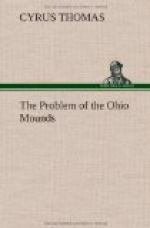Here the Delaware tradition drops them, but the echo comes up from the hills of East Tennessee and North Carolina in the form of the Cherokee tradition already mentioned, telling us where they found a resting place, and the mound testimony furnishes the intermediate link.
If they stopped for a time on New River and the head of the Holston, as Haywood conjectures, [Footnote: Nat. and Aborig. Hist. Tenn., p. 223.—See Thomas, “Cherokees probably mound-builders,” Magazine Am. Hist., May. 1884, p. 398.] their line of retreat was in all likelihood up the valley of the Great Kanawha. This supposition agrees also with the fact that no traces of them are found in the ancient works of Kentucky or middle Tennessee. In truth, the works along the Ohio River from Portsmouth to Cincinnati and throughout northern Kentucky pertain to entirely different types from those of Ohio, most of them to a type found in no other section.
On the contrary, it happens precisely in accordance with the theory advanced and the Cherokeee traditions, that we find in the Kanawha Valley, near the city of Charleston, a very extensive group of ancient works stretching along the banks of the stream for more than two miles, consisting of quite large as well as small mounds, of circular and rectangular inclosures, etc. A careful survey of this group has been made and a number of the tumuli, including the larger ones, have been explored by the representatives of the Bureau.
The result of these explorations has been to bring to light some very important data bearing upon the question now under consideration. In fact we find here what seems to be beyond all reasonable doubt the connecting link between the typical works of Ohio and those of East Tennessee and North Carolina ascribed to the Cherokees.
The little stone vaults in the shape of bee-hives noticed and figured in the articles in Science and the American Naturalist, before referred to, discovered by the Bureau assistants in Caldwell County, N. C., and Sullivan County, Tenn., are so unusual as to justify the belief that they are the work of a particular tribe, or at least pertain to an ethnic type. Yet under one of the large mounds at Charleston, on the bottom of a pit dug in the original soil, a number of vaults of precisely the same form were found, placed, like those of the Sullivan County mound, in a circle. But, though covering human remains moldered back to dust, they were of hardened clay instead of stone. Nevertheless, the similarity in form, size, use, and conditions under which they were found is remarkable, and, as they have been found only at the points mentioned, the probability is suggested that the builders in the two sections were related.




